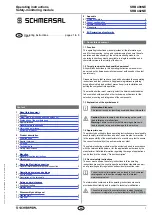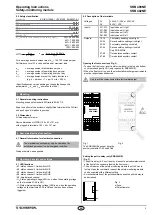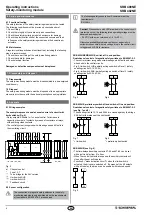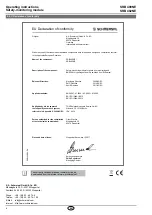
3
SRB 400NE
SRB 402NE
Operating instructions
Safety-monitoring module
EN
2.5 Safety classification
Standards:
EN ISO 13849-1, IEC 61508, EN 60947-5-1
PL:
up to e
Control category:
up to 4
DC:
99% (high)
CCF:
> 65 points
SIL:
up to 3
Service life:
20 years
B
10D
value (for one channel of the relay output):
20%: 20,000,000
40%: 7,500,000
60%: 2,500,000
80%: 1,000,000
100%: 400,000
MTTF
B
d x
x
h
s/h
3600
D
10D
op
op
op
n
0,1 x n
op
t
cycle
For an average annual demand rate of n
op
= 126,720 cycles per year,
Performance Level PL e can be obtained at maximum load.
n
op
= average number of activations per year
d
op
= average number of operating days per year
h
op
= average number of operating hours per day
t
cycle
= average demand rate of the safety function in s
(e.g. 4 × per hour = 1 × per 15 min. = 900 s)
(Specifications can vary depending on the application-specific
parameters h
op
, d
op
and t
cycle
as well as the load.)
3. Mounting
3.1 General mounting instructions
Mounting: snaps onto standard DIN rails to EN 60715.
Snap the bottom of the enclosure slightly tilted forwards in the DIN rail
and push up until it latches in position.
3.2 Dimensions
All measurements in mm.
Device dimensions (H/W/D): 100 x 45 x 121 mm
with plugged-in terminals: 120 × 45 × 121 mm
4. Rear side Electrical connection
4.1 General information for electrical connection
The electrical connection may only be carried out by
authorised personnel in a de-energised condition.
Wiring examples: see appendix
5. Operating principle and settings
5.1 LED functions
• K1: status channel 1, limit switch LHS
• K2: status channel 2, limit switch LHS
• K3: status channel 1, limit switch RHS
• K4: status channel 1, limit switch RHS
• K5: time-delayed channel
• U
B
: Status operating voltage (LED is on, when the operating voltage
on the terminals A1-A2 is ON)
• U
i
: Status internal operating voltage (LED is on, when the operating
voltage on the terminals A1-A2 is ON and the fuse has not been
triggered)
5.2 Description of the terminals
Voltages:
A1
A2
+24 VAC / VAC or 230 VAC
0 VAC / VDC
Inputs:
S11-S12
S11-S22
S31-S32
S41-S42
Input channel 1 right
Input channel 2 right
Input channel 1 left
Input channel 2 left
Outputs:
13-14
23-24
33-34
43-44
57-58
67-68
First safety enabling circuit right
Second safety enabling circuit right
First safety enabling circuit left
Second safety enabling circuit left
Only SRB 402NE:
Time-delayed auxiliary contact
Time-delayed auxiliary contact
Opening the front cover (see Fig. 2)
• To open the front cover, insert a slot screwdriver in the top and bottom
cover notch and gently lift it (only required for SRB 402NE).
• When the front cover is open, the electrostatic discharge requirements
must be respected and observed.
Only touch the components after electrical discharge!
U
B
U
i
K1
K2
K3
K4
K5
X1 X2 57 58
A2 S14 S23 X3
X3
S41
X4
A1
13 14 23 24
33
43
34
44
A1 S13 S24 X2
41
23
13
33
42
24
14
34
SRB 402NE*
U
B
U
i
K1
K2
K3
K4
K5
X1 X2 57 58
A2 S14 S23 X3
X3
S41
X4
A1
13 14 23 24
33
43
34
44
A1 S13 S24 X2
41
23
13
33
42
24
14
34
SRB 402NE*
U
B
U
i
K1
i
K2
K3
K4
K5
X1 X2 57 58
A2 S14 S23 X3
X3
S41
X4
A1
13 14 23 24
33
43
34
44
A1 S13 S24 X2
41
23
13
33
42
24
14
34
SRB 402NE*
Fig. 1
The SRB 400NE does not have the
auxiliary contacts 57-58 and 67-68
Fig. 2
Setting the pull-in delay (only SRB 402NE)
(Fig. 3)
• The pull-in delay (0...5 sec) is set by means of a potentiometer located
at the front of the enclosure (behind the front cover).
• The pull-in delay of the safety-monitoring module is set to 5 sec in
factory. Upon the customer's request, the safety-monitoring module
can be supplied with a different setting.
• A clockwise rotation of the potentiometer causes the pull-in delay to
be decreased.
b)
a)
Fig. 3
a) Fuse;
b) Potentiometer
























